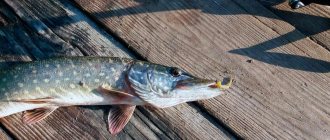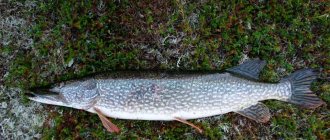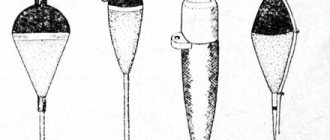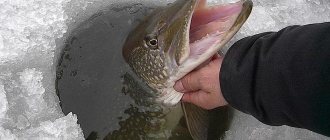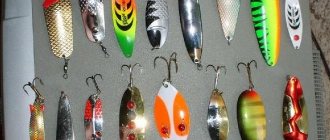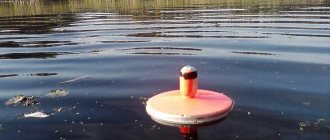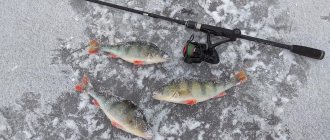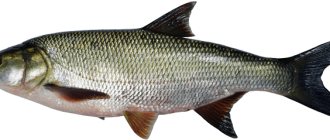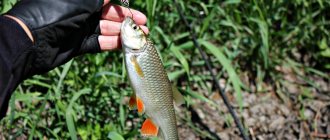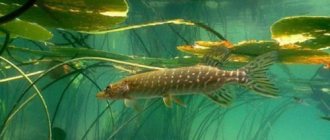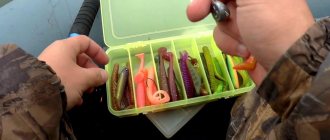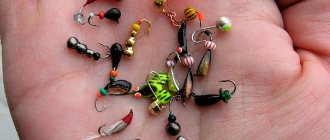Pike is one of the main objects of spinning fishing. This is because this predator is widespread. It can be found on large and small rivers, ponds and lakes. For most spinners, pike was their first trophy. And someone starts to get involved in spinning fishing just to catch a toothy predator.
How to assemble a spinning rod for pike fishing - form, reel, cord, equipment
How to choose a spinning rod for pike for beginners
The first thing you need to start assembling gear for a toothed predator is choosing a spinning rod. Its quality will determine what kind of game the bait can be set. Therefore, you need to familiarize yourself with the parameters of the rods and choose the appropriate option for yourself.
Some athletes and even amateurs prefer to use different forms for different baits, since they can reveal the game of baits differently. However, this option is more practical when fishing from a boat. In coastal fishing, when you have to walk a lot, carrying several sets of rods with you is not very practical. But you can try to choose a universal fishing rod for your fishing characteristics.
Spinning rod equipment for pike fishing schematically
The first thing you should pay attention to is the length of the rod. If fishing is planned on a small river, with heavily overgrown banks, then you can opt for a short rod, 2.1 meters long. If the branches do not interfere with casting, and the cast itself needs to be cast further, you can use longer spinning rods.
The rod test indicates what weight of bait is recommended to be used. If the bait is smaller than the stated test, then it will be extremely difficult to animate it, and it will also not be possible to cast a bait that is too light for the fishing rod. At the same time, if the bait is very heavy for a spinning rod, there is a risk of breaking it. For pike fishing, a medium class rod is most often suitable. Ultralight is used less often. Among ultralight spinning rods, Shimano Catana can be noted.
To set the correct bait action, you need to use a rod of a suitable action. So, to twitch wobblers you will need a spinning rod with a fast and super-fast action, such as the Favorite X1. Thanks to the rigidity of the stick, you can fully unleash the potential of these lures. For fishing with spinners and silicone, a medium action rod, such as the Favorite New Spirit, is suitable.
Build the form
A good spinning rod for pike for jig and twitch fishing:
Which reel to choose for spinning for pike
A spinning reel for pike fishing can be either spinning or multiplier. Meat grinders are more common among our fishermen.
For spinning fishing, the weight of the reel plays an important role. It should not be heavy, since the spinning rod is constantly in the hands.
Therefore, you should abandon heavy traction reels in favor of small and medium-sized spinning reels. A spool size of 2500-3000 will be sufficient, such as in Shimano Stradic. This is a universal size for dough forms 10-30, 5-21 grams.
The location of the front clutch is convenient, as it can be adjusted during fishing. The quality of the reel will determine the wiring, as well as how the cord will be laid on the spool. And this, in turn, will avoid the formation of beards.
Choosing braid for fishing
To catch pike with a spinning rod, use a line. It does not stretch and allows fish pokes to be clearly transmitted to the tip of the rod. Also, the cord does not dry out over time and does not have a memory effect like fishing line. Cords are marked by the weight they can support in pounds, expressed in lb. Select Basic PE 12 lb cord is good for pike.
What kind of leash is needed for pike fishing?
The last important element of the tackle is the leash. It is useless to hunt for pike without a leash, as it easily bites the fishing line and cord. The best pike leashes are steel, titanium and fluorocarbon.
Titanium leads assemble well on crimp tubes
The simplest option is a twisted string. This is the cheapest consumable. The disadvantage is that it becomes deformed over time. Other steel leaders, such as titanium ones, are also used for pike fishing. Also, the use of fluorocarbon leaders is quite common. But they need to be selected based on the expected catch size, since pike can still bite through fluorocarbon if the diameter is insufficient.
How to assemble a spinning rod for pike fishing so that the tackle is balanced and catchy, how to choose a rod, reel, cord and how to balance and equip it all:
The best bait for pike
Today, specialized stores offer a large number of effective and catchy baits, each of which has its own characteristics.
Spoons
Spinners are classic lures for spinning fishing, they are divided into 2 main types:
- Rotating models can make luring sounds at depth, attracting a predator.
- Oscillating lures lure pike by making oscillatory movements during the retrieve.
Spoons are the simplest baits that do not require much experience and skill to operate. They have high strength and durability, often hooked with double and triple hooks. The most popular and effective oscillating models.
Wobblers
Wobblers are mainly offered made of plastic, foam or wood. Their goal is to imitate the movements of bait fish in the water; sometimes they make calling sounds (ringing, buzzing, etc.)
Wobblers have the following advantages:
- Similarity to live bait.
- Strength.
- Successful imitation of the movements and sounds of fish.
But it is worth noting that wobblers are quite expensive.
Oscillator
Spinning baits are highly effective; they imitate the infrequent movements of a fish on its side. They are mainly made of durable material with a metallic sheen. Many models are made with a relief applied to make them more interesting to the predator.
For effective pike hunting, the following spoons are the most interesting:
- The Kuusamo Rasanen model is characterized by a wide range of bright colors and types.
- Mepps Cyclops jigs best imitate the movement of small baitfish.
- “ACME Little Cleo” differs from its analogues by the presence of a special mound that attracts pike.
Spinnerbaits
Special spinnerbaits are characterized by special sound vibrations emitted in the water. The design consists of an elastic wire at the base with petals fixed on both sides and a disguised hook.
An important advantage of these baits is that they are practically not susceptible to snagging, which is why they are so popular for fishing in reeds, aquatic vegetation, and snags.
Silicone and foam baits
Among the most popular silicone lures for pike fishing are the following:
- Crustaceans.
- Twisters.
- Squid.
- Vibrating tails.
Silicone baits such as worms are often used to set up drop shots.
These baits are mainly used for bottom gear, so a sinker is always included in the package.
Let's celebrate! Foam rubber baits are used as jig baits, which in the process of action raise the tail and show high buoyancy. As a result, the foam rubber bait imitates a sick fish, which is ready to become bait for a predator.
Jig baits
Jig baits or designs with jig heads are used effectively to catch predatory fish. Foam rubber jig baits include only stepped bottom wiring during the fishing process. This allows you to simulate a sick fish as realistically as possible.
Many models are equipped with sinkers of the Cheburashka design with a flooded ring or offset hook. Thanks to this, it is possible to achieve protection from snags and the ability to fish in snags and algae.
Homemade lures for pike
Many experienced fishermen know how to make inexpensive budget baits from available materials. For example, it is possible to make a shiny bait from a spoon, which a predatory fish will surely bite on.
To make bait, you must follow the following recommendations:
- You need to take an unnecessary spoon from your household.
- Use pliers to remove the handle of the spoon, and file the pointed edge.
- Use a nail and hammer to make holes on both sides.
- In the future, attach double hooks, tees or carabiners to the holes, at your discretion.
Live bait for pike
The best bait for catching pike is a live fish caught shortly from the same reservoir. This lure is mainly used as a float rod in open water fishing.
The following are considered the most popular live bait:
- Crucian carp.
- Ruff.
- Perch.
- Bleak.
- Roach.
- Gudgeon.
The dimensions of live bait are selected based on the expected size of the future catch; the most common are live bait from 8 to 17 cm in length. For fishing in spring, you can use fish larger than 15 cm in size as bait.
For live bait, there are 2 main ways to attach a fish for maximum catchability:
- “By the back” - the nozzle is passed through the side, through the dorsal fin, but in this case it is important not to damage the spine. Most often, the technique is carried out for reservoirs with high currents.
- “By the lip” - insert the hook through the mouth, palate, the outlet should be located in the nostril. The most popular and effective method for fishing in still water.
Let's celebrate! Thanks to the proper placement of live bait on the hook, the bait remains alive for a long time and attracts predatory pike.
Set of lures for pike fishing
Lures are selected for specific fishing circumstances and the preferences of pike at a given time. Pike are caught using spoons, wobblers, silicone and surface baits.
The toothy predator has always responded well to hardware. Catching a pike with a spinner or a spinner using a uniform retrieve is not very difficult if it is active in principle. Mepps spinners of the Aglia long series with an oblong petal of the third number have proven themselves to be good for pike. Among the spinners, we can mention the Atom spinner.
Mepps Aglia Long
In autumn it is difficult to do without wobblers such as Rudra and Orbit. These minnows provoke hungry autumn pike to bite.
Zipbaits Orbit 110 sp - a typical autumn wobbler
In spring and autumn, you can rely on using a jig. To catch pike, use larger than average lures of 3.5 inches in length. Full-bodied vibrating tails are good, like barrels such as Select Shad One. The best colors in clear water are machine oil and ultraviolet light, in cloudy water - acidic colors.
Tandem - spinner + vibrating tail
In summer, when reservoirs are heavily overgrown with grass, it is advisable to use surface baits, poppers, as well as ducklings, mice, and toads. Pike actually feed on various living creatures that fall into the water. Therefore, they are familiar food for her.
Catching pike with surface lures is a separate art form. It's nice to watch the beautiful attacks and candles of this strong fish.
How to catch pike in the fall
To catch pike in the fall, you need to know that at this time the fish intensively stores fat for the long winter. In the fall, the pike bite is, of course, not as strong as in the spring, but it is more even and stable.
When to catch pike in the fall?
You need to catch pike in the fall at sunrise and end at sunset, since the temperature drops rapidly and pike are more active during the day than in summer.
Where to catch pike in the fall?
A decrease in temperature, an increased level of water transparency, the movement of smaller fish to greater depths - all this leads to the fact that the pike begins to hide in holes as deep as possible. There, in fact, she needs to be caught.
What to use to catch pike in the fall?
Various means are good for catching pike in the fall. It is preferable to catch pike with a spoon. Almost any bait will do. Most often, spinning rods are combined with spinners; in most cases, spinners are more suitable, although so-called spinners may also be suitable.
Finding a predator on a pond
Searching is an integral part of spinning fishing. Spinning fishing is largely exploratory. The spinner's task is to find where the pike can stand, and only then try to entice it to cast by playing the bait.
There are two tactics for spinning fishing. Firstly, stick to one place, changing the bait, its game and presentation. But for this you need to be sure that there are fish at this point. The second option is to look for active fish. Experienced spinning anglers already have their own proven places where it is known that pike are located. And even when fish are caught from this place, the holy place is not empty for long. A promising place is quickly occupied by a competitor.
Details about spinning fishing for pike and other predatory fish from the shore:
Fishing with a spinning rod from the shore for beginners: how to assemble, throw a form and successfully catch a predator
How to catch pike with a spinning rod - where to look and how to fish from the shore and boat on a lake, pond and river
This fish prefers to attack from an ambush. She has her own parking places. Knowing such places, you can methodically fish for them. Even without knowing such places on a particular body of water, you can pay attention to some features of the body of water that will tell you where the pike may be.
Secrets of catching large pike using a spinning rod:
Fishing tactics on the lake
Pike in closed reservoirs often migrate from one place to another. Promising places for toothfish on a lake may be small backwaters where the shoreline curves, there are windows in the grass, as well as the border of thickets and clear water.
It is often easier to fish with a spinning rod on a lake than on a river. To achieve success, you can change fishing locations. It is also worth methodically fishing each place using the fan method, including moving the bait along the coastline. Experiment with wiring and baits. On lakes, pike respond to smoother and slower retrieves than on rivers.
Tactics on the river
On the river, pike have many promising places to stay. These are pools and backwaters of the river, as well as snags in the water and the shadow of hanging tree crowns. Deep slumps, channel and bank edges, bends in the banks, places of reverse flow.
Small rivers allow you to fish the entire horizon directly from the shore. On large rivers it is advisable to use boats. On rivers you can use the entire arsenal of baits and experiment with wiring.
Search tactics on the reservoir from a boat
For fishing in the reservoir, an echo sounder may be required. This is because the fish in the reservoir are very “diluted with water” and finding them can be difficult. In addition, to fish in a reservoir, you need to find anomalies on the bottom or just deep places, which an echo sounder will also help with.
In reservoirs they fish with heavy baits, as well as by trolling from a boat.
The most popular lures for catching pike
When going fishing with any gear, you need to carefully prepare; one form with a reel and fishing line will not be enough. An important element on which the outcome of fishing directly depends is the bait; without it, the capture will definitely not happen.
Spinning lures for pike are divided into several types, and each of them can attract the attention of a predator no worse than the others. The choice is influenced by various indicators, among which the important ones will be:
- test indicators of the form;
- reservoir criteria;
- weather;
- season;
- the size of the predator living in the reservoir.
It is also worth taking into account the personal preferences of the fisherman; some prefer to fish only with silicone, while others only bite with a wobbler.
A novice spinning angler needs to try all the baits and only then independently choose the one he likes.
It’s very difficult for a beginner to decide on his own; the store shelves with gear amaze with their variety. That is why it is necessary to take a mentor with you or study the range of products on your own before going on a trip. We will try to help you a little with your choice; to do this, we will study in more detail the most catchy spinning lures for pike.
Wobblers
This type of bait for pike is very popular. It is the wobbler that is most similar to real fish, and not only visually. It is made in such a way that, when placed in water, it imitates aquatic inhabitants as much as possible; most often, wobblers imitate a dead fish or a very fast fry.
But this is not all the information about the bait; wobblers are divided according to body shape; for pike they are most often used:
- cranks;
- minnow;
- poppers;
- jerky.
The wiring for this type of bait can be varied, in most cases it all depends on the shape and characteristics of the reservoir. Twitch, uniform and uneven wiring will give you catchability. In this case, it often happens that the fisherman himself must choose the most suitable one, and sometimes combine several at once.
It is worth understanding that this bait for pike is also divided by buoyancy. There are:
- drowning;
- floating;
- with neutral buoyancy.
It is also necessary to distinguish a wobbler by its depth; for this you need to carefully examine the shovel, it will be the correct indicator of immersion. The larger the size, the deeper the wobbler will go when moving it through the water column.
It’s worth paying attention to the colors; a real spinning fisher’s arsenal should include both bright acid baits and lures with a more natural body color.
It is better to select a larger size for pike if you want to get a trophy specimen of the predator.
Spinner
One of the most popular for pike is a spinner. It often happens that a toothy resident of a pond does not respond to any of the proposed baits, but it is the spinner that attracts its attention and forces it to attack.
Experienced fishermen recommend always having several types of spinners in your box; the most catchy ones are considered to be:
- Aglia;
- Aglia long;
- Black Fury;
Spinner baits of this type are the most catchy from Mepps; Blue Fox produces excellent quality and a specific shaped core; those who use large-sized Ponton 21 also get good results.
Many craftsmen make such lures on their own; their products are often even superior in catchability to branded ones.
The color of the petal of a spinner is of great importance; its choice should be taken responsibly. It is advisable to have all the basic ones without fail, but purchase an acid one as needed.
Oscillating spoon
Pike responds well to oscillators throughout the year; the main thing is to know how to use them in reservoirs. There are a lot of varieties of baits of this type; they are distinguished by shape, weight, and color.
The most popular are:
- Castmaster;
- Syclops;
- many models from Spinnex.
You should choose a bait of this type based on the time of year, the depth of the reservoir, and also take into account the size of the inhabitants of the river or lake. Models with a silver body are considered universal baits, but there is no need to remove gold and bronze from your arsenal at all.
Acid-colored pike baits are also popular with experienced fishermen; pike especially often react to cyclops with this coloring. Spinner baits from Spinex are no less popular; they are caught both on lakes and rivers in different regions.
The retrieve for such a spinner should be uniform, but fast. This is how the spinner can best imitate a quickly fleeing fish, and the predator will rush to catch up with it.
Stickers are equipped with ordinary hooks, often tees. But for wiring between water lilies or other bottom vegetation, it is better to install non-snagging hooks.
Silicone
Silicone baits are among the most budget-friendly ones; another advantage is that installation can be done in several ways.
Approaching a display case with silicone, even the most experienced spinning player will be confused. Today's stores can offer a wide variety of baits of this type. Spinning attachments for pike are distinguished by:
- size;
- color;
- body shape;
- tail shape.
Silicone from the edible series is included in a separate group; there is also plenty to choose from.
The same manufacturers have been the most popular for many years; their products always work in any weather. The best lures for pike are made by:
- Manss;
- Relax;
- Lucky John.
But the shape can be very diverse; vibrating tails are most often preferred, they are most similar to fish. Twisters can also attract the attention of pike; special attention should be paid to frogs made of silicone, worms, crustaceans, and leeches. Each of the above baits will be able to attract the attention of a pike and, with proper wiring, the predator will definitely be hooked.
Wiring for this type of bait is used in different ways; uniform, twitch, and stop and go are suitable.
Pike can be caught using spinning rods and other baits, but these are the ones that are used most often and effectively.
How to catch pike with a spinning rod from the shore - fishing tactics and strategy
Coastal pike fishing somewhat limits the spinning angler's choice of places. Some places you just can't get to. However, if it is a small lake, a river backwater or a small river, shore fishing can bring good results.
Often for shore fishing you will need a longer rod to make longer casts. Shore fishing involves fishing at shallow depths.
Fishing for pike with a spinning rod - watch the video on how to find a predator, what baits to use, how to retrieve, how to tire out a pike when fishing after a bite:
Choosing bait depending on conditions
Often fishing conditions dictate what bait to use. For example, when fishing in heavily overgrown places, it will not be possible to use wobblers with many tees. In such places it is good to use surface baits, as well as offset silicone. Silicone baits will also allow you to fish in heavily snagged areas.
Correct placement of the bait on the offset machine
Twitching
This type of animation is used for fishing with wobblers. Twitch using rods with fast and super-fast action. Soft rods will not be able to give the wobbler the desired action.
Twitch is called torn wiring with jerks. At the same time, the wobbler jerks in different directions and freezes for a moment, which provokes the predator to attack.
Wobblers are used at depths of up to 2-4 meters. There are also diver wobblers, the use of which is relevant up to 5-8 meters.
Jig fishing
Jig fishing is used with silicone baits. With the help of jig wiring you can push through the entire horizon of water.
Classic jigging is: tossing the bait from the bottom, then a pause, during which the bait smoothly sinks to the bottom, and then jerking and reeling again.
Video of catching pike with a spinning rod in 2021 - fishing with jigs, rattlins, fishing tactics, technique and fishing:
Spinner fishing
It is best to start mastering spinning fishing with spinners. This is because uniform wiring is perfect for fishing with spoons. Spoons have their own game, which can be set even with even wiring.
Oscillating spoons can also be used in stepped retrieves, allowing the bait to sink to the bottom.
How to throw a spinning rod when fishing for pike over your head:
Power casting spinning rod:
Fishing for pike in the spring with a spinning rod
In spring, it makes sense to look for pike in different places. At the beginning of spring, the toothed predator is still inactive and inactive. However, the so-called winter spinning has become widespread. Pike is caught in small rivers or in ice-free water bodies. Although the fish is inactive, you can still find the key to it.
In early spring, fishing is not much different from winter spinning. The fish is in deep places; you need to look for it in holes, for example using a jig. As soon as the water warms up to 5-8 degrees, the pike begins its pre-spawning feast.
The predator begins to visit for future use before spawning. At this time, she actively feeds and begins to come closer to the shore for schools of fry. It has been noticed that in the spring small or elongated baits work better.
Experienced fishermen attribute this to the fact that the predator’s belly is filled with caviar, and it will be difficult for it to swallow a large fish. The pre-spawning feeding period does not last long, only a couple of weeks.
In spring, pike bite aggressively in the westerly wind, especially good if there is a light drizzle on the water
Then the pike begins to spawn when it stops taking bait. After spawning, the fish gets sick for some time; as people say, it “changes its teeth.” As soon as the pike recovers from spawning, it begins to actively bite again. Usually this time falls in the month of May. The fish begins to occupy their usual summer camp sites. Smaller pike remain in shallow water, in the grass and in the reeds.
In spring, you can often catch a pike hatch just in the middle of the day.
Mistakes when fishing for pike with a spinning rod - how to catch it correctly, what gear to use:
Wobblers
Wobblers are a type of bait made of plastic or wood. The shape of its manufacture and behavior in the water resembles a wounded or sick small fish that can easily be caught by a predator.
Wobblers are considered one of the most catchy baits; these baits can be purchased in Chinese online resources or specialized stores in different shapes, colors and sizes. The varieties of wobblers are so numerous that the fisherman, just as in the case of spinners and spinners, has only one option left - to solve this crossword puzzle on his own and choose the most working options for himself experimentally, directly on the reservoir. At different times of fishing, completely opposite fish can work.
In order to correctly determine and buy the same copy, you need to take into account some factors:
- buoyancy;
- color and coloring;
- immersion depth;
- nozzle game;
- sizes.
When it's hot, in late July/early August, pike prefer to stay on top, and that's when floating wobblers come in handy.
The neutral buoyancy of the wobbler means that the bait is kept at a certain depth and its wiring allows it to withstand the given task; such a wobbler becomes interesting to pike at the beginning and end of summer.
The negative buoyancy of a wobbler is very useful when fishing in the fall (late September) and spring, when the toothy predator just begins to go to depth, sinking autumn wobblers become real and easy prey for large pikes.
On a bright and sunny day, according to anglers, pike like bright blue and blue colors; it is on them that it prefers to quickly attack. If it is small enough, you can use bronze and silver shades of fish.
The buoyancy of a wobbler is also different; each manufacturer immediately indicates its immersion on the body of the bait.
The depth directly depends on the angle of inclination of the wobbler blade and its design. The depth of immersion of the nozzle depends on the fishing speed of the fisherman. The higher the speed of the retrieve, the deeper the fish and, accordingly, vice versa, with slow winding of the fishing line. Tips for a fisherman: How to choose a spinning rod for pike fishing - Tips for a beginner
How actively the pike will react depends on the action of the bait. Therefore, the ideal option is torn, twitching wiring of the wobbler to create the impression of a wounded or sick fish. On many types of wobblers, the rubber is specially marked with some appearance of an injured fish.
Modern wobblers are made from the following materials:
Fishing in summer
In summer, pike activity decreases somewhat. They catch pike in the summer using a variety of baits in a variety of places. Pike is an ambush predator. Therefore, she prefers to stay near natural shelters, in flooded trees, in grass and reed walls.
Due to the fact that in summer the reservoirs are actively overgrown with grass, spinning fishing in some of them becomes problematic. Therefore, summer is the time to use surface baits such as poppers, Croatian eggs, ducks, toads, and small-depth spoons.
In the summer, the hours for catching predators may change. Pike do not like the hot sun. Therefore, the time of its activity shifts to early morning or evening. Pike activity in summer can be observed during temporary cooling after rains and on cloudy days. Starting in August, when the water temperature begins to drop, pike become more active.
How to catch a pike with a spinning rod, in the video there is real pike fishing - gear, bait, wiring:
What bait and equipment to choose according to the season?
Depending on the fishing season, it is necessary to accurately select high-quality and effective bait for pike.
Properly selected equipment, specifically for pike, ensures high fishing efficiency and the opportunity to catch a predatory trophy.
Spring
Spring is the only time when predatory pike bites on any bait.
In the spring, pike begin to actively eat and it is better to start catching large trophies with small live bait. Perform all wiring slowly, choosing a light spoon with small vibrations.
If you are making a lure for a predator yourself, it is better to give preference to materials coated with silver or copper. Pike responds well to bright wobblers and spinners; the designs should include bright colorful stripes and spots.
Summer
This is the period when the pike has already finished spawning and the time for active rest begins. In this case, you should choose small-sized baits, experimenting with shades.
In summer, it is best to choose bright rotating lures for pike. In hot, sultry times, pike baits need to be chosen a little smaller in size.
The most effective lure for pike in the summer is from 5 cm to 10 cm in length. This is ensured by the high hydroacoustic wave properties of this bait, to which predatory fish respond well.
A good summer bait is the spinner, which is well suited for beginners trying to master spinning.
Autumn
In warm autumn, pike stores fat for the winter and at this time active feeding begins. Wiring is best done at great depths, choosing for this purpose vibrators with active movements. For reservoirs with cold water, spinners with slow movements are more effective.
During the warm autumn, pike try to gain weight in order to survive the winter, so it is worth preparing in advance for autumn fishing for predatory fish. At this time, it is necessary to choose large wobblers and spinners; small ones are unlikely to interest a predator.
Experts recommend choosing a lure for pike larger than 10 cm in order to withstand restive pike. At this time, it will have to be pulled out from the depths; wiring should be done in stages, slowly with pauses.
Winter
In the cold season, pike fishing should be done with jig baits and artificial fish.
In winter, pike are passive and it is better to fish in rivers and backwaters. Experienced fishermen recommend choosing balancer baits; in winter, pike hide in holes and holes at the bottom.
To improve the bite and surely go home with a trophy pike, you can use several methods to increase your catch:
- Pheromone bite activator, which is successfully used in cold and warm water.
- Pheromone-based lures.
- Increasing the sensitivity level of pike rigs.
- Increasing the strength of gear.
Let's celebrate! Many tackles and additional attributes can be easily made independently. There are several ways to catch pike with bait; it is only important to choose a delicate approach depending on the season and select the right bait.
Fishing in autumn
Autumn is a classic time for catching trophy specimens. Catching pike at this time is not difficult. The predator increases its activity during this period and begins to gain fat before winter.
The peak of the autumn bite occurs in mid-October - early November. In autumn, the toothy predator does not disdain large baits. This is the time to experiment with larger crankbaits and silicone.
In autumn, the grass begins to fall on reservoirs, which allows you to catch predators in a larger water horizon.
